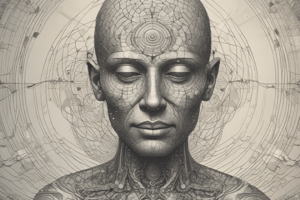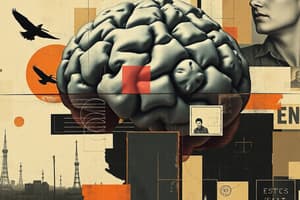Podcast
Questions and Answers
What does the cognitive approach compare the mind to?
What does the cognitive approach compare the mind to?
- A living organism
- A mathematical model
- A network of neurons
- A computer (correct)
What is required for an algorithm according to the cognitive approach?
What is required for an algorithm according to the cognitive approach?
- Random guessing
- Subjective feelings
- Goals and constraints (correct)
- Immediate feedback
Which view posits that perception is shaped by both experiences and innate assumptions?
Which view posits that perception is shaped by both experiences and innate assumptions?
- Constructive view (correct)
- Dual processing theory
- Mirroring view
- Direct realism
What is the availability heuristic primarily concerned with?
What is the availability heuristic primarily concerned with?
Marr’s three levels of explanation do NOT include which of the following?
Marr’s three levels of explanation do NOT include which of the following?
What is the main function of the lookup table in a Turing machine?
What is the main function of the lookup table in a Turing machine?
Which of the following statements best describes the Church-Turing Thesis?
Which of the following statements best describes the Church-Turing Thesis?
What does the 'NAND' operation signify in classical computation?
What does the 'NAND' operation signify in classical computation?
Which of the following is NOT a characteristic of classical computational theory of mind?
Which of the following is NOT a characteristic of classical computational theory of mind?
What distinguishes René Descartes’ Dualism related to the mind and matter?
What distinguishes René Descartes’ Dualism related to the mind and matter?
Flashcards are hidden until you start studying
Study Notes
Cognitive Science
- Definition: The study of the mind and intelligence. Not phenomenology, psychoanalysis, behaviorism, or biology
- Cognitive Approach: Views the mind as a computer processing information and utilizing algorithms.
- Algorithms: Step-by-step processes for generating outputs from inputs, requiring goals and constraints.
- Perception: Shaped by prior experiences and assumptions about the environment, with two main views:
- Constructive: Involves imagining an object based on past experiences.
- Mirroring: Assembling data to make assumptions about the environment.
- Global Workspace Theory of Consciousness: Perceptual information is selected for broadcast to other brain systems, entering awareness.
- Memory and Availability Heuristic: Memory availability is a type of mental shortcut, where we estimate probabilities based on how readily we recall examples.
- Internal Maps: Studies like the mouse study show that we have internal representations of the world.
Levels of Explanation
- Computational Systems: Different abstraction levels are needed to ask diverse questions about a system.
- Levels of Abstraction: Goals, inputs/outputs, representation, transformation, physical implementation.
- Marr's Three Levels:
- Computational Theory: Determines the system's goals and properties.
- Representation and Algorithm: Details the information format and manipulation rules.
- Hardware Implementation: Describes the physical components involved.
- Ultimatum Game Example: Illustrates the application of Marr's levels to decision-making.
- Representation: Choices are represented as continuous-valued intensities.
- Algorithm: Intensities compete with each other.
- Implementation: Neurons execute the process.
Classical Computation
- Early Computing Devices: Charles Babbage created a mechanical adding machine and Ada Lovelace devised a computer program for it.
- Turing Machine: A theoretical model with a tape, current position, state, and a lookup table for instructions.
- Church-Turing Thesis: Any computation humans can perform using pencil and paper can be done by a Turing machine.
- Turing Machine Implementation: Represents the algorithmic/representational level of Marr's framework.
- Universal Turing Machine: Capable of performing any possible computation given the right inputs.
- NAND Operation: A universal operation, meaning other logical operations can be built from it.
- Classical Computational Theory of Mind: The mind is a computational system employing algorithms and representations similar to a Turing machines.
- Computational Framework: Memory representations are discrete symbols, algorithms consist of steps, and it allows for non-traditional elements like parallel computation or probabilistic transitions.
- Connection to Physical Systems: Mental processes can be implemented using physical objects, like neurons.
- Descartes' Dualism: Matter and mind are distinct substances.
- General-Purpose Programmable Computer: Humans can be programmed to compute anything computable, but specific mental processes might not be programmable.
Neural Network Computation
- Limitations of Classical Computers: Underperform at tasks like categorization, generation, and problem solving compared to humans.
- Artificial Neural Networks: Models of human thought inspired by the brain.
- Evolution of Neural Networks: Became more sophisticated in the 1980s, with breakthroughs in image recognition in 2015.
- Components: Nodes (neurons), weights, activation functions, objective functions, and learning algorithms (e.g., backpropagation).
- Neural Network Process: Input is fed through the network, the output is measured, and backpropagation adjusts weights for improved accuracy.
- Comparison to Human Mind: Some similarities exist, but human brains require less training and have different learning mechanisms.
- Evolutionary Training: Could have provided baseline learning for humans.
- Intuitive Physics: Artificial neural networks struggle with tasks that are easy for humans.
- Brain as a Neural Network: The Carl Cox study on monkey brains has influenced this view.
Representation
- Synesthesia: Perceiving one sense in terms of another.
- Types: Sound-color, color-sound, auditory-tactile, day-color, grapheme-color
- Possible Explanation: Proximity of sensory brain regions.
- Format: The family of features of a representation.
- Access: Who understands the representation.
- Types: Basic (colored regions), complex (concrete objects/abstract truths), population codes (allowing for more representations and robustness to errors).
- Content: Identifying the content of representations.
- Methods: Task performance, response time, errors, and location of representation.
- Imagery Debate: Whether internal representations are sentence-like or picture-like.
- Pylyshyn: Sentences.
- Kosslyn: Pictures.
- Aphantasia: Inability to visualize.
- Hyperphantasia: Extremely vivid imagery.
Modularity
- Modular Features: Encapsulation, specialization, localization.
- Evidence for Modularity: Aimes rooms (evidence for modulation) and classroom experiments (evidence against).
Development
- Nativism: Innate elements of cognition.
- Learning: Refines representations and algorithms.
- Empiricism: General-purpose pattern detectors.
- Knowledge Acquisition: Through life experiences.
- Core Cognition Hypothesis: Humans are born with specialized cognitive systems for numbers, objects, and agents.
- Cognitive Development:
- Object Permanence: Understanding objects' continuous existence, even when hidden.
- Centration: Reasoning based on a single, salient aspect of a situation.
- Theory of Mind: Understanding that others have different minds.
- Overregularization: Grammatical errors in language development (e.g., "goed" instead of "went").
Nature vs Nurture
- Evolutionary Influence: Genes for brain development determine cognitive processing.
- Shared Genes: Explain similarities across individuals.
- Environmental Impact: Monkey study demonstrates that lack of visual experience impacts behavior, supporting the nurture perspective.
- Heritability Index: Explains the genetic contribution to a trait's variability.
- Twin Studies: Compare identical twins with fraternal twins to assess genetic contributions.
- Genome-Wide Complex Trait Analysis: Models the relationship between genes and traits.
- Life Experience: Twin studies suggest that family environment may be less significant than life experiences.
- Gene Expression: Genes influence the brain and guide environmental selection.
- Genotype and Phenotype: Evolution focuses on genotypes (genes).
Evolutionary Psychology
- Brain Size and Energy Consumption: High energy consumption despite relatively small size.
- Galapagos Finches: Illustrates how environmental changes cause anatomical shifts.
- Phenotype Plasticity: Genes expressed under specific conditions.
- Pleiotropy: Single gene influencing multiple phenotypes.
Brain
- Neuroscience Basics: Dendrites receive information, synapses transmit messages, and chemical signaling alters neuron voltage.
Brain Scanning
- Neuroimaging Methods: Provide information about brain structure and function.
- Measures: Brain activity, structure, and connectivity.
- Applications: Understanding cognition, identifying brain disorders, and monitoring brain changes over time.
Studying That Suits You
Use AI to generate personalized quizzes and flashcards to suit your learning preferences.



